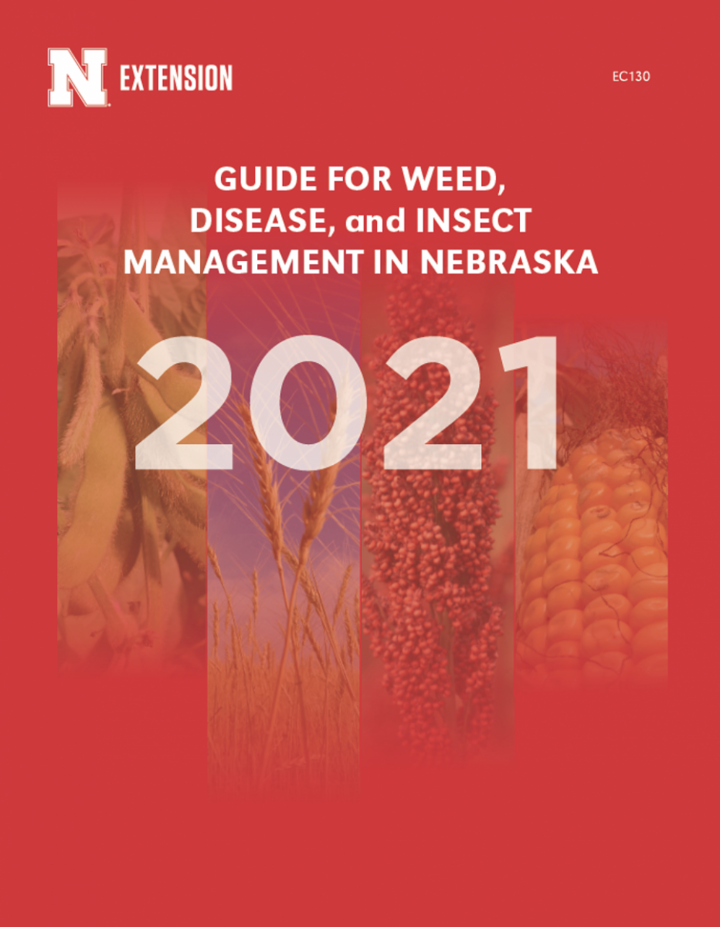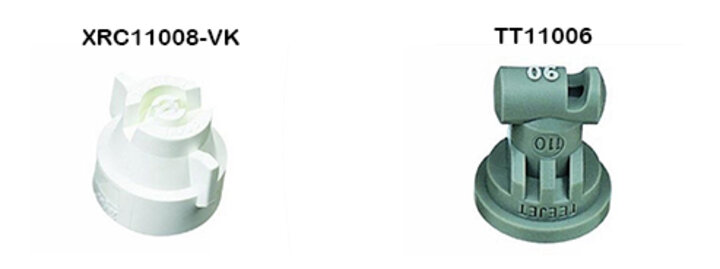| The Guide Pesticide Application Topics | |
|---|---|
| Application Equipment and Practices | 1 |
| Reducing Drift | 39 |
| Herbicide Application Terms | 39 |
| Nozzle Selection | 40 |
| Nozzle Selection for Pulse Width Modulation | 56 |
| Spray Boom Setup | 61 |
| Calibrating Sprayers | 63 |
| Preparing Spray Solutions | 66 |
| Tank-Mixture Compatibility | 67 |
| Herbicide and Fertilizer Compatibility | 68 |
| Spray Additives | 69 |
| How to Spray a Field | 73 |
| Cleaning the Sprayer | 76 |
| UAN to Keep Sprayer from Freezing | 86 |
| Soybean Yield Loss from Sprayer Tracks | 86 |
| Individual Plant Treatment Techniques | 87 |

Let’s examine one of the topics listed to the right. This is a new topic listed in the 2021 Guide.
Soybean Yield Loss from Ground Sprayer Wheel Tracks — Page 86
University of Wisconsin-Madison and Iowa State University conducted research on wheel track damage from ground sprayers. Findings were that soybean plots with stands of more than 100,000 plants per acre and planted late April through Mid-May did not suffer any yield loss when sprayed with a self-propelled sprayer with narrow tires at the R1 growth stage (at least one flower on any node). Lower populations and later plantings may suffer yield loss during this period if sprayed. On average, it takes about four days to move from R1 to R2 (full flower).
After R1 through harvest, damage due to sprayer wheel tracks can reduce yields. Yield losses always occurred with 15-inch and narrower rows. With 30-inch rows, yield loss occurred in half of the research trials. The following chart shows research and estimates for soybean yield loss using a self-propelled sprayer with narrow tires and sprayed after R1. Plant populations were at least 100,000 per acre and were planted late April to mid-May.
| Sprayer Boom Width | % Yield Loss |
|---|---|
| 60 ft | 2.5 x 80 bu/ac = 2 bu |
| 80 ft | 2.1 |
| 90 ft | 1.9 |
| 100 ft | 1.7 |
| 120 ft | 1.3 |
When making pesticide applications, our two concerns are pesticide efficacy and spray drift. We want the best results from the application on the target but must be concerned with spray drift. Let’s discuss spray drift.
It is estimated that two-thirds of pesticide drift problems involve mistakes which could have been avoided. Drift is of concern because it takes the pesticide from the intended target, making it less effective, and deposits it where it is neither needed nor wanted. The pesticide then becomes an environmental pollutant in the off-target areas, where it can injure susceptible vegetation, contaminate water or damage wildlife. Drift cannot be eliminated but the use of proper equipment and application procedures will maintain the drift deposits within acceptable limits.
There are two kinds of drift:
Particle drift is off-target movement of the spray particles.
Vapor drift is the volatilization of the pesticide molecules and their movement off target.
A Mississippi State University study analyzed data from more than 100 studies involving drift from ground sprayers. Of the 16 variables considered, three were most important.
1. Wind speed. When the wind speed was doubled, there was almost a 700% increase in drift when the readings were taken 90 feet downwind from the sprayer. Hence the recommendation of spraying in 10 mph winds or less.
2. Boom height. When the boom height was increased from 18 to 36 inches, the amount of drift increased 350% at 90 feet downwind.
3. Distance downwind. If the distance downwind is doubled, the amount of drift decreases five-fold. Therefore, if the distance downwind goes from 100 to 200 feet, you have only 20% as much drift at 200 feet as at 100 feet and if the distance goes to 400 feet, you only have 4% of the drift you had at 100 feet. Check wind direction and speed when starting to spray a field. You may want to start spraying one side of the field when the wind is lower. Also, it may be necessary to only spray part of a field because of wind speed, wind direction and distance to susceptible vegetation. The rest of the field can be sprayed when conditions change.
Pesticide drift also can be reduced by using one of the new types of tips and by adjusting spray pressure. Higher spray pressures produce smaller droplets, which are more susceptible to drift. If using a rate controller, be careful of increased speed. Since most rate controllers increase the pressure to maintain the same gpa when the speed increases, try to maintain the speed within +10%. For example, if you’re applying 20 gpa at 8 mph at 40 psi and you increase the speed to 11 mph, the pressure will now be 75.5 psi, which will produce a lot of small particles prone to drift. Also, this pressure will be above the operating range of most tips. Drift reduction agents may be helpful.
New spraying technology such as the “blended pulse” can decrease the risk of drift by allowing flow rate to be controlled independently of spray pressure.
Nozzle Selection for Droplet Size — Pages 44-50
- Many pesticide labels now list recommended or required spray droplet size(s) for application. Follow label guides to increase pesticide efficacy and help manage spray drift. Droplet size classes are based on BCPC specifications and in accordance with ASABE standard S572.1
- The following problem will ask you the appropriate spray droplet sizes and ground application rates in gallons per acre. In the 2021 The Guide (EC130), use the charts that start on page 44.
Problem:
- You will treat field corn with the herbicide Callisto XTRA. Use the chart on page 44 of the 2021 The Guide (EC130).
| Herbicides | Drop Size Classification | Ground Application GPA, Page 44 |
|---|---|---|
| Broadaxe XC | Minimal Amts of Fine Spray | Minimum 10 |
| Brox2EC | L | Minimum 10 |
| Butyrac 200 | C-but nozzle types that will provide adequate coverage | Minimum 10 |
| Cadet | M-C | Minimum 15; up to 40 for dense canopy or weeds |
| Callisto 4SC | Coarse or Coarser | Pre: 10 to 60 & POST: 10 to 30 |
| Callisto GT | M-C | Minimum 10 |
| Callisto XTRA | Coarse or Coarser | 10 to 30 |
| Callisto XTRA Enhanced | M-C | Minimum 10 |
| Canopy Blend | M | Minimum 10 |
| Canopy DF | C to VC | Minimum 10 |
| Canopy EX | M,C | Minimum 20 |
| Caparol | L | Minimum 10 |
Problem:
- What spray droplet size? Coarse or coarser is listed.
- We will use coarse.
- What ground application rate (GPA)? 10 to 30 GPA is listed.
- Use 20 GPA to insure better coverage.
- You have a sprayer with:
- 15-inch nozzle spacing
- Calibrated delivery rate of 20 GPA at 12 mph
Using the chart on page 53 of the 2021 The Guide (EC130), what nozzle would be a good choice?
| Nozzle Spacing | ||||
|---|---|---|---|---|
| Speed MPH | Rate gpm | 20-inch | Rate gpm | 15-inch |
| 6 | 0.404 | TT11004@41 psi** | 0.303 | AIXR110025@59 psi |
| 7 | 0.471 | TT11005@36 psi* | 0.354 | TT11004@31 psi OR AIXR11003@56 psi |
| 8 | 0.539 | TT11005@46 psi | 0.404 | TT11004@41 psi** |
| 10 | 0.673 | XRC11010-VP@18 psi* OR TT11006@50 psi** | 0.505 | TT11005@41 psi |
| 12 | 0.808 | XRC11010-VP@26 psi | 0.606 | XRC11008-VK@23 psi or TT11006@41 psi |
*Just into the next larger spray drop size with water — many pesticides and additives reduce the spray drop size
**Just into spray drop size

Using the chart on page 53 of the 2021 The Guide (EC130), what nozzle would be a good choice?
XRC11008-VK @ 23 psi or TT11006 @ 41 psi
Comments follow on Spray Nozzles for Pulse Width Modulation (PWM) Systems, which are listed on Pages 56-60
The PWM system has a set pulse frequency. Duty cycle (DC) is the amount of time a digital signal is on over a period of time, often given as a percentage. For example, a 70% DC means that every tenth of a second, the nozzle is spraying for 70% of the tenth of a second. The sprayer can keep pressure constant over changes in speed or rate, because it modulates the duty cycle to spray the full volume as required by the application. In other words, operating a sprayer at 70% duty cycle means that the digital signal is on 70% of the time period; a nozzle will apply 70% of the amount the nozzle would apply with the same solution and pressure. Some nozzle spacings will better fit the desired volume median diameter (VMD), pressure and speed parameters. A nozzle may not be available for the desired VMD, pressure and speed parameters at a 30-inch spacing. Consider using 15-inch nozzle spacing instead.
